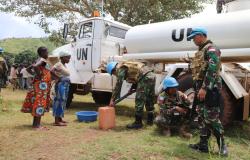Protection Experiences of Military Peacekeepers and Civilians in Somalia and the DRC

Jutta Bakonyi and Anne Flaspöler introduce two papers exploring the experiences of civilians and peacekeepers in Somalia and the DRC.
Peacekeeping is commonly associated with images of blue helmets, white UN vehicles, soldiers delivering aid and shaking kids’ hands in war-torn countries. With the changing environment of peace operations and the peacekeeping failures in Rwanda and Srebrenica, the Protection of Civilians mandate advanced into a core rationalisation for ‘robust’ forms of peacekeeping. In light of these changes, our research project[1] explored how the Protection of Civilians mandate is experienced now that military peacekeepers are allowed to use force against rebel groups attacking civilians and so-called peace spoilers. We chose two long-term missions for our investigation – the United Nations (UN) peace operation in the DRC (MONUSCO) and the African Union (AU) peacekeeping mission in Somalia (AMISOM[2]) – and interviewed African military peacekeepers about their experiences of implementing protection practices as well as the civilians as recipients of these efforts.
We found a mixed and ambiguous picture that illustrated appreciation and understanding of the complexities of peacekeeping by civilians. It, however, also emphasised civilians’ expectations, which were gradually overshadowed by distrust and disappointment. Given this critique, many civilians voiced a preference for national security forces for their protection (stronger emphasis in Somalia) as they appeared more visible, easier accessible, and more consistent in their work. Civilians emphasised a life in insecurity, where threats of violence overshadowed any protection efforts conducted by AMISOM and MONUSCO and eroded their trust in these missions and the peacekeeping personnel. In both countries, peacekeepers were experienced as inaccessible, hiding behind walls, staying safe on their bases, in airport zones, and in their tanks during patrols and convoys, while civilians suffered at the hands of armed groups. Consequently, they were regularly described as passive, not caring, selfish and insular. A lack of improvement in the security landscape, despite initial successes, led to civilians questioning the peacekeepers’ as well as the UN’s or AU’s motivations for their deployment. Hence, civilians frequently expressed a preference for their exit.
The military peacekeepers were committed to the protection of civilians, which most interviewees understood as their core task, beyond support for combating rebels and insurgents. Military peacekeepers in both MONUSCO and AMISOM also emphasised their difficulties in deciphering and making sense of their context, outlining challenges to operationalise protection in a hostile environment, where some villagers threw stones when peacekeepers approached their village, where national security providers were viewed with mistrust, and, as some also emphasised, in a context where the political will towards peace seemed lacking. Especially their difficulties in differentiating civilians from combatants, and not knowing who to trust, was a recurring topic, as many peacekeepers felt that they always had to expect ‘the enemy’ hiding among the civilians. Peacekeepers also discussed what they perceived as rejection based on misunderstandings of civilians – a topic that was especially vibrant in the DRC, where interviewees had witnessed demonstrations against them, some even turning into riots and requiring the support from the national police forces. Peacekeepers, nonetheless, remained convinced about the positive impact of their presence and peacekeeping activities.
Overall, engaging with accounts of both civilians and military peacekeepers, a need for relationship- and trust-building became apparent, which becomes increasingly difficult in volatile peacekeeping settings. Despite the efforts made to establish relations through Community Liaison Officers or Female Engagement Teams (in the DRC) and by providing quick impact projects, these efforts were experienced as sporadic and unable to bridge the gap that has developed, partly due to the security measures to ensure peacekeepers’ safety. While the overwhelming majority of civilians approved of the more active use of force within peacekeeping, they were disappointed that it did not produce the results they had expected causing frustration about their continued lack of security, irrespective of the AU or the UN heading the mission.
While this is a very brief summary, we encourage readers to gain a more detailed insight into the narratives of both civilians and military peacekeepers by reading our papers about the military peacekeepers’ [download the first paper here] as well as the civilians' accounts [download the second paper here].
Jutta Bakonyi, Professor in Development and Conflict in the School of Government and International Affairs.
Anne Flaspöler, Assistant Professor in International Relations in the School of Government and International Affairs.
Notes
[1] This was an AHRC/FCDO (AH/T007451/1) funded project.
[2] During our research, AMISOM was replaced by the African Union Transition Mission in Somalia (ATMIS), which was replaced by the African Union Stabilization and Support Mission in Somalia (AUSSOM) in January 2025.


